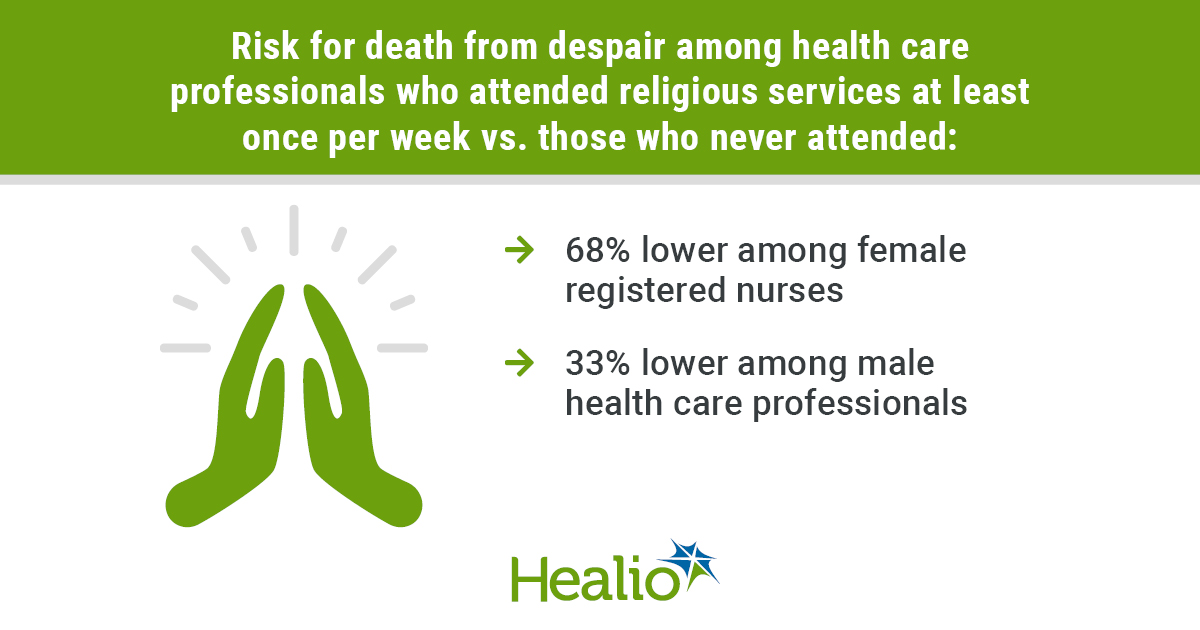Religious service attendance linked to significantly lower risk for death from despair

Frequent religious service attendance appeared associated with lower risk for death from despair among health care professionals, according to results of a population-based cohort study published in JAMA Psychiatry.
These findings may provide insight into trends in deaths from despair in the general population, researchers noted.
“There has been a substantial increase in deaths related to suicide, drug and alcohol use over the past 2 decades in the United States, especially among middle-aged, non-Hispanic white, working-class individuals,” Ying Chen, ScD, empirical research scientist at Harvard Institute for Quantitative Social Science’s Human Flourishing Program, told Healio Psychiatry. “Economists Anne Case and Angus Deaton coined the term ‘death of despair’ for these deaths because they may share a context of hopelessness and indifference toward living. Although the term was originally coined in the context of working-class Americans struggling with unemployment, we believe despair is a phenomenon that is relevant more broadly and can confront anyone dealing with hard times. It is, therefore, important to identify resources and assets that can help prevent such deaths, and these results suggest that religious community may be one such resource.”
Few empirical studies have investigated the antecedents associated with despair-related deaths. Chen and colleagues sought to partially address this research gap by prospectively examining the association between deaths from despair and religious service attendance. They analyzed data from self-reported questionnaires and medical records of 66,492 female registered nurses included in the Nurses’ Healthy Study II (NHSII) from 2001 through 2017. They also analyzed data of 43,141 male health care professionals, such as dentists, pharmacists, osteopaths, podiatrists, optometrists and veterinarians, included in the Health Professionals Follow-up Study (HPFS) from 1988 through 2014. The researchers obtained data on causes of death from medical records and death certificates.

As the exposure, they used self-reported religious service attendance at study baseline in response to the question, “How often do you go to religious meetings or services?” Main outcomes and measures included deaths from despair, which the researchers defined as deaths from suicide, unintentional poisoning by alcohol or drug overdose, and chronic liver diseases and cirrhosis. They used Cox proportional hazards regression models to estimate the HR of deaths from despair by religious service attendance at study baseline and adjusted for baseline sociodemographic characteristics, medical history, psychological distress, lifestyle factors and other aspects of social integration.
Chen and colleagues identified 75 and 306 incident deaths from despair among the NHSII and HPFS participants, respectively. Fully adjusted models revealed that risk for death from despair among those who attended services at least once per week was 68% lower (HR = 0.32; 95% CI, 0.16-0.62) in NHSII and 33% lower (HR = 0.67; 95% CI, 0.48-0.94) in HPFS compared with those who never attended religious services.
“In this study, the reductions in the risk for death from despair associated with religious service attendance seem fairly substantial and are worth further considerations,” Chen told Healio Psychiatry. “Some potential next steps may be to investigate these associations in a more general population and to understand mechanisms through which religious participation may help individuals confront despair. The present pandemic of COVID-19 may be a source of despair for some, while many communal religious gatherings have necessarily been suspended. We need to continue exploring approaches to navigate these challenges and extend help to those at risk for despair.”
In a related editorial, Marino A. Bruce, PhD, MSRC, MDiv, of the Program for Research on Faith and Health at Vanderbilt University’s Center for Research on Men’s Health, and colleagues highlighted potential areas of inquiry for future related research.
“Close reading of this article provides some exciting potential avenues of inquiry at the interface of religiosity, spirituality and health,” they wrote. “The robust results from an analysis of individuals with social privilege and high-stress occupations during middle and late life reported [by Chen and colleagues] pave the way for the next generation of health disparities research with nuanced considerations of key factors, such as status in society, despair, stress, religious participation and religious coping and hope.” – by Joe Gramigna
Disclosures: One study author reports grants from the Robert Wood Johnson Foundation outside the submitted work. The other study authors report no relevant financial disclosures. Bruce and one editorial author report grants from the National Institute on Aging, and another editorial author reports grants from the National Institute on Aging and the National Center for Advancing Translational Science.

